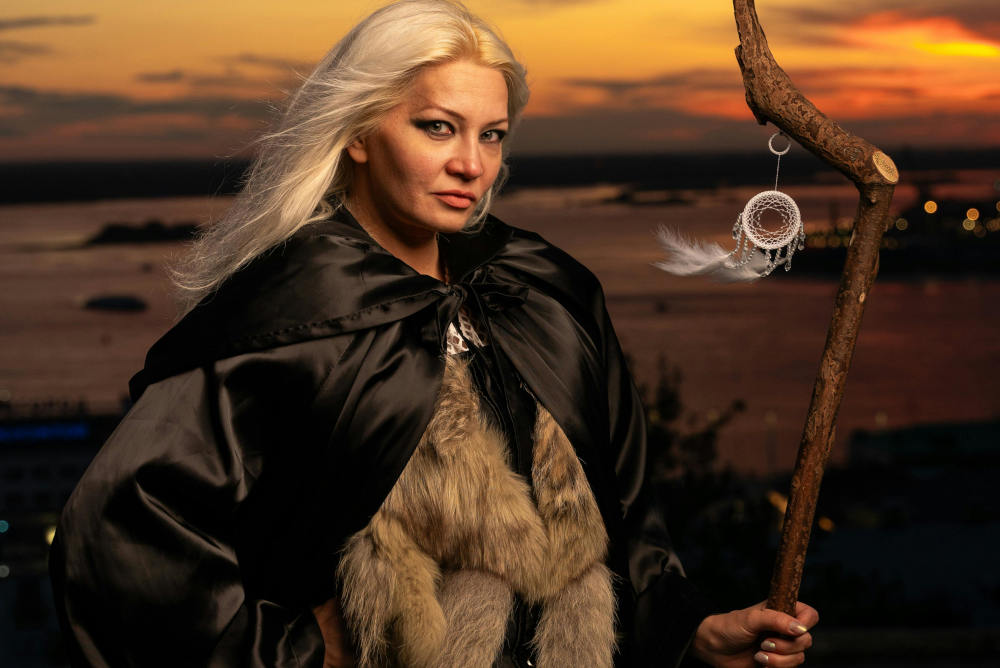
Druidentum und Wicca sind zwei der bekanntesten Richtungen des modernen Heidentums. Beide ehren die Natur, feiern den Wechsel der Jahreszeiten und stellen persönliche spirituelle Erfahrungen über Dogmen. Sie sind jedoch nicht dasselbe. Druidentum und Wicca haben unterschiedliche Ursprünge, Glaubensvorstellungen, Rituale und philosophische Grundstrukturen.
Dieser Artikel befasst sich mit den Ähnlichkeiten und Unterschieden zwischen den spirituellen Pfaden der Druiden und der Wicca – er räumt mit Unklarheiten auf und hilft den Lesern zu verstehen, was sie voneinander unterscheidet.
Panaprium ist unabhängig und wird vom Leser unterstützt. Wenn Sie über unseren Link etwas kaufen, erhalten wir möglicherweise eine Provision. Wenn Sie können, unterstützen Sie uns bitte monatlich. Die Einrichtung dauert weniger als eine Minute und Sie werden jeden Monat einen großen Beitrag leisten. Danke schön!
Überblick: Druidentum und Wicca
Was ist Druidentum?
Druidentum oder Druidentum ist ein spiritueller Weg, der von den alten keltischen Druiden inspiriert ist – Priestern, Dichtern, Richtern und Philosophen im Britannien, Irland und Gallien der Eisenzeit. Obwohl die ursprünglichen Druiden keine schriftlichen Aufzeichnungen hinterließen, ist das moderne Druidentum eine Rekonstruktion und kreative Wiederbelebung, die auf Mythologie, Folklore, Archäologie und naturbezogener Spiritualität basiert.
Der moderne Druidentum entstand im 18. und 19. Jahrhundert während der keltischen Renaissance und wurde im 20. Jahrhundert mit der Gründung von Organisationen wie diesen strukturierter:
-
Der Orden der Barden, Ovaten und Druiden (OBOD)
-
Ár nDraíocht Féin (ADF – Eine Druidengemeinschaft)
-
Das Druidennetzwerk
Das moderne Druidentum ist im Allgemeinen undogmatisch und umfasst Menschen mit polytheistischen, pantheistischen, agnostischen oder sogar atheistischen Ansichten. Es konzentriert sich auf die Verbindung mit der Natur, die Ehrung der Vorfahren, das Feiern der Jahreszeiten und die Förderung von Kreativität, Weisheit und innerem Frieden.
Was ist Wicca?
Wicca ist eine moderne heidnische Religion, die Mitte des 20. Jahrhunderts von Gerald Gardner gegründet wurde, einem britischen Beamten, der behauptete, in einen noch existierenden Hexenzirkel eingeweiht worden zu sein. Wicca verbindet Elemente zeremonieller Magie, Naturverehrung, Volkstraditionen und westlicher Esoterik.
Wicca gewann in den 1960er und 70er Jahren an Popularität und hat sich seitdem in viele verschiedene Traditionen verzweigt, wie zum Beispiel:
-
Gardnerianische Wicca
-
Alexandrinische Wicca
-
Eklektische Wicca
-
Dianische Wicca
Wiccans glauben im Allgemeinen an eine Göttin und einen Gott (die oft die weiblichen und männlichen Prinzipien repräsentieren), praktizieren Magie, feiern die acht Sabbate des Jahreskreises und befolgen einen ethischen Kodex, der als Wicca-Rede bekannt ist: „Solange es niemandem schadet, tu, was du willst.“
Wichtige Ähnlichkeiten
Bevor wir uns mit den Unterschieden befassen, sollten wir uns die Gemeinsamkeiten zwischen Druiden und Wiccans ansehen.
1. Naturbasierte Spiritualität
Beide Wege betrachten die Natur als heilig. Die Praktizierenden ehren den Kreislauf der Jahreszeiten, die Elemente (Erde, Luft, Feuer, Wasser) und die Verbundenheit allen Lebens.
2. Feier des Jahresrades
Druiden und Wiccans feiern beide acht große Feste:
-
Samhain (Ende der Ernte, Ahnenverehrung)
-
Yule (Wintersonnenwende)
-
Imbolc (erste Anzeichen des Frühlings)
-
Ostara (Frühlings-Tagundnachtgleiche)
-
Beltane (Fruchtbarkeits-/Feuerfest)
-
Litha (Sommersonnenwende)
-
Lughnasadh oder Lammas (erste Ernte)
-
Mabon (Herbst-Tagundnachtgleiche)
Diese Feste markieren natürliche Übergänge im Jahr und sind Zeiten für Rituale, Besinnung und Gemeinschaft.
3. Ehrfurcht vor den Vorfahren
Beide Wege ehren die Vorfahren als Quelle der Weisheit und Verbindung zur Vergangenheit, insbesondere zu Zeiten wie Samhain.
4. Flexible, undogmatische Überzeugungen
Sowohl Druidentum als auch Wicca lassen persönliche Interpretation zu. Es gibt kein zentrales heiliges Buch, keine starre Doktrin und auch nicht die Verpflichtung, an eine bestimmte Theologie zu glauben.
Hauptunterschiede zwischen Druiden und Wiccans
1. Historische Wurzeln
-
Der Druidismus ist von der alten keltischen Kultur und der Priesterklasse der Druiden inspiriert, die als Richter, Philosophen und spirituelle Führer fungierten. Er ist stark von der irischen und walisischen Mythologie und Überlieferung geprägt.
-
Wicca ist eine Erfindung des 20. Jahrhunderts, die zeremonielle Magie, Volkshexerei und Esoterik verbindet. Obwohl Wicca einige Elemente des antiken Heidentums verwendet, handelt es sich nicht um die direkte Wiederbelebung einer einzelnen historischen Religion.
2. Gottheiten und Theologie
-
Druiden können polytheistisch (Glaube an viele Götter, insbesondere aus dem keltischen Pantheon), animistisch (Glaube an die Existenz von Geistern in der Natur), pantheistisch oder agnostisch sein. Manche Druiden legen mehr Wert auf die spirituelle Verbindung zur Natur als auf die Anbetung von Gottheiten.
-
Wiccans verehren typischerweise eine Göttin und einen Gott (manchmal auch den Gehörnten Gott genannt), die Dualität und Gleichgewicht repräsentieren. Viele Wiccans betrachten das Göttliche als immanent und in der Natur zum Ausdruck gebracht.
Verschiedene Traditionen innerhalb der Wicca betonen möglicherweise unterschiedliche Gottheiten oder kombinieren verschiedene Pantheons in einem eklektischen Ansatz.
3. Verwendung von Magie und Ritualwerkzeugen
-
Wiccans praktizieren aktiv rituelle Magie , oft „das Handwerk“ genannt. Zu den Ritualen gehören üblicherweise das Ziehen eines Kreises, das Rufen der Himmelsrichtungen (Nord, Süd, Ost, West) und der Einsatz von Werkzeugen wie:
-
Athame (Ritualmesser)
-
Zauberstab
-
Kelch
-
Pentagramm
-
Wiccans können Zauber zur Heilung, zum Schutz, für Wohlstand oder spirituelles Wachstum ausführen.
-
Druiden können Magie praktizieren, müssen es aber nicht. Manche konzentrieren sich eher auf Meditation, Poesie, ökologisches Bewusstsein und saisonale Rituale als auf Zauberkunst. Druidische Magie ist in der Praxis eher subtil und basiert eher auf Naturgeistern, Intuition und Symbolik als auf strukturierter zeremonieller Magie.
4. Organisationsstruktur und Schulung
-
Das Druidentum folgt oft einer dreigliedrigen Struktur, die von alten keltischen Rollen inspiriert ist:
-
Barden : Künstler, Geschichtenerzähler, Dichter
-
Ovaten : Seher, Heiler, Wahrsager
-
Druiden : Ritualführer, Philosophen
-
Viele Druidenorden bieten eine mehrjährige strukturierte Ausbildung in diesen Bereichen an.
-
Wicca , insbesondere in seinen Initiationsformen (wie der Gardnerianischen oder Alexandrinischen), beinhaltet oft eine Zirkelstruktur mit Initiationsstufen und geheimen Ritualen. Einzelgänger können ohne formelle Initiation unabhängig studieren und praktizieren.
5. Philosophischer Fokus
-
Der Druidentum legt Wert auf Harmonie mit der Natur, künstlerischen Ausdruck, spirituelle Ökologie und persönliche Transformation durch Weisheit und Einsicht. Viele Druiden engagieren sich intensiv im Umweltaktivismus.
-
Wicca legt mehr Wert auf Rituale, heilige Polarität (Göttin und Gott), magische Praktiken und persönliche Ermächtigung durch die Verbindung mit göttlichen Energien.
Während beide Wege ein ethisches Leben fördern, beziehen sich Wiccans oft auf das Dreifache Gesetz – die Idee, dass das, was Sie tun, dreifach zu Ihnen zurückkommt.
Ethik und Moralkodex
-
Wiccans folgen dem Wicca-Leitsatz: „Solange es niemandem schadet, tu, was du willst.“ Diese Richtlinie betont persönliche Verantwortung und Harmlosigkeit.
-
Druiden folgen im Allgemeinen einer natürlichen Ethik des Respekts vor dem Leben, der Erde und der Gemeinschaft, doch es gibt kein einheitliches moralisches Gesetz. Stattdessen leiten Prinzipien wie Gerechtigkeit, Wahrheit (bekannt als Wahrheit im Herzen ) und Ausgeglichenheit ihr Verhalten.
Rituelle Unterschiede
-
Wicca-Rituale werden normalerweise innerhalb eines Zirkels durchgeführt und folgen einem festgelegten Ablauf, der die Anrufung von Gottheiten, das Rufen der Himmelsrichtungen, die Durchführung magischer Arbeit und das Auflösen des Zirkels umfasst.
-
Druidenrituale finden oft im Freien, in heiligen Hainen oder in der Natur statt. Sie können Opfergaben an Naturgeister, poetische Anrufungen, Meditation und die Feier der Jahreszeiten beinhalten, sind jedoch abwechslungsreicher und legen oft weniger Wert auf Zaubersprüche.
Symbolik und Werkzeuge
-
Zu den Wicca-Symbolen gehören das Pentagramm, der dreifache Mond (der die Aspekte der Göttin als Jungfrau, Mutter und Alte darstellt) und rituelle Werkzeuge wie der Kessel oder der Zauberstab.
-
Zu den Symbolen der Druiden gehören die Awen (drei Lichtstrahlen, die Inspiration darstellen), die Triskele (drei ineinandergreifende Spiralen) und heilige Bäume wie Eiche, Esche und Eibe.
Geschlecht und das Göttliche
-
Wicca betont die heilige Polarität und betrachtet Göttin und Gott oft als gleichwertig und komplementär. Einige Traditionen (wie Dianic Wicca) sind auf die Göttin fokussiert und auf die Frau ausgerichtet.
-
Das Druidentum ist tendenziell fließender. Während einige Druiden mit männlichen und weiblichen keltischen Gottheiten arbeiten, verehren andere die Natur selbst als göttlich, ohne strenge Geschlechterzuordnungen.
Moderner Ausdruck
Beide Traditionen werden weltweit praktiziert und entwickeln sich ständig weiter. Manche Menschen vermischen Elemente des Druidentums und der Wicca zu vielseitigen spirituellen Praktiken. Andere entscheiden sich aufgrund kultureller Interessen, persönlicher Resonanz oder philosophischer Überzeugungen für einen Weg.
Einige wichtige Unterscheidungsmerkmale in der modernen Praxis:
-
Der Druidentum spricht oft Menschen an, die sich zum keltischen Erbe, zum Geschichtenerzählen, zum Umweltschutz und zum spirituellen Naturalismus hingezogen fühlen.
-
Wicca zieht oft Menschen an, die sich für rituelle Magie, göttliche weibliche Spiritualität und strukturierte zeremonielle Praktiken interessieren.
Fazit: Unterschiedliche Wege, gemeinsame Wurzeln
Druidentum und Wicca sind unterschiedliche spirituelle Traditionen, doch sie haben viele Werte gemeinsam: Ehrfurcht vor der Natur, Feier der Jahreszeiten, persönliche Ermächtigung und ein ethisches Leben.
Der Druidentum konzentriert sich stärker auf Naturverbundenheit, Kreativität und keltisch inspirierte Weisheit. Wicca verbindet rituelle Magie, die Verehrung zweier Gottheiten und persönliche Transformation durch das Handwerk.
Keiner der beiden Wege ist besser oder authentischer als der andere – sie bieten einfach unterschiedliche Möglichkeiten, sich mit der spirituellen Welt auseinanderzusetzen. Ob Sie sich von der poetischen, naturverbundenen Weisheit der Druiden oder der mystischen, magischen Praxis der Wicca angezogen fühlen, beide Wege bieten tiefgreifende Möglichkeiten, im Einklang mit der Erde zu leben und spirituelles Bewusstsein zu wecken.
War dieser Artikel hilfreich für Sie? Bitte teilen Sie uns in den Kommentaren unten mit, was Ihnen gefallen oder nicht gefallen hat.
About the Author: Alex Assoune
Wogegen Wir Kämpfen
Weltweit-Konzerne produzieren in den ärmsten Ländern im Übermaß billige Produkte.
Fabriken mit Sweatshop-ähnlichen Bedingungen, die die Arbeiter unterbezahlt.
Medienkonglomerate, die unethische, nicht nachhaltige Produkte bewerben.
Schlechte Akteure fördern durch unbewusstes Verhalten den übermäßigen Konsum.
- - - -
Zum Glück haben wir unsere Unterstützer, darunter auch Sie.
Panaprium wird von Lesern wie Ihnen finanziert, die sich unserer Mission anschließen möchten, die Welt völlig umweltfreundlich zu gestalten.
Wenn Sie können, unterstützen Sie uns bitte monatlich. Die Einrichtung dauert weniger als eine Minute und Sie werden jeden Monat einen großen Beitrag leisten. Danke schön.































0 Kommentare